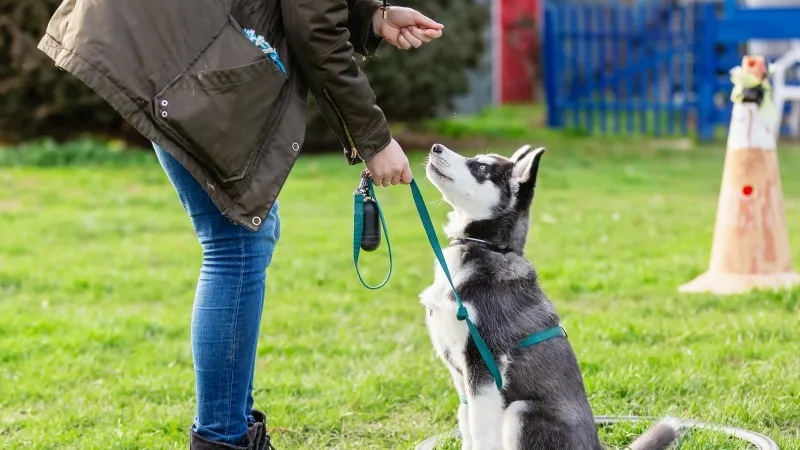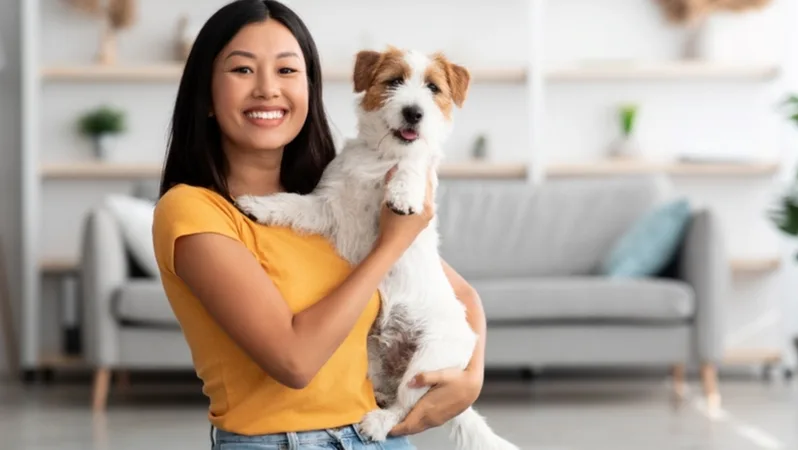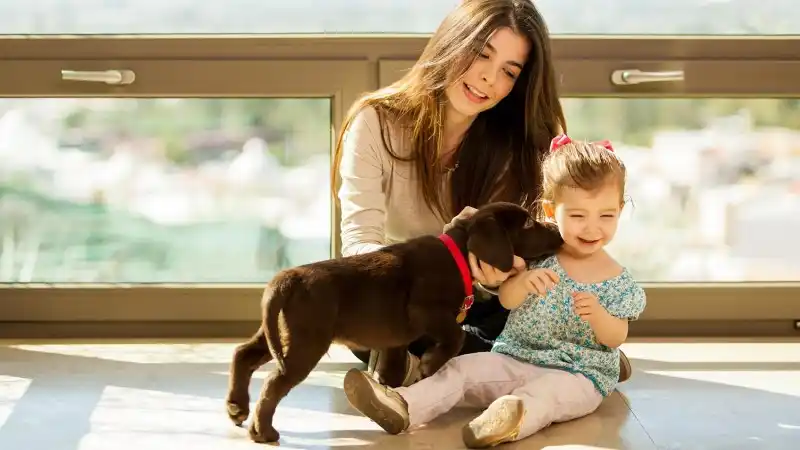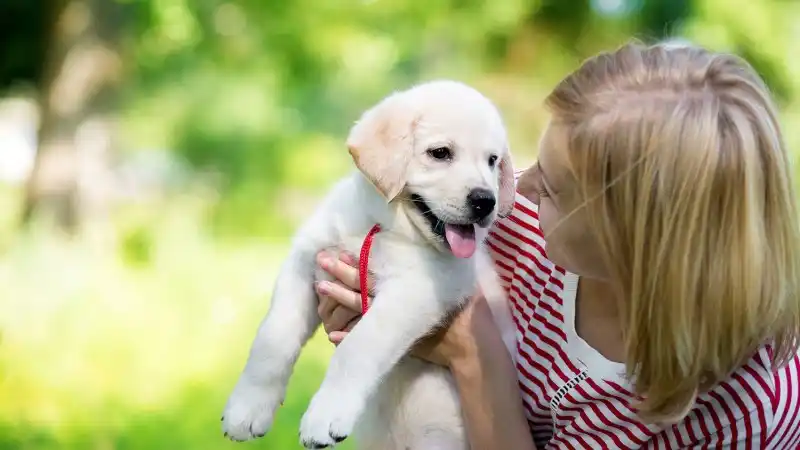AKC Pet Insurance Celebrates Dog Training Month
Dog training is essential for a happy & well-balanced pet. Here are tips for socializing a puppy, crate training, stopping your dog from jumping & chewing, and more.

Training your dog is an important part of their overall happiness and well-being. Not only does it help them learn the basic behaviors they need to be a well-behaved canine citizen, but training also offers important safety precautions and helps you strengthen your communication skills with your pup.
There's no better time to start training your dog than January, National Train Your Dog Month. Read on to learn how to train your dog and combat stubborn behavior problems.
Socializing Your Puppy
If you've just adopted a new puppy, socialization should be one of the first steps you take in your training journey.
The first three months of your puppy's life are the critical socialization period, and the more experiences you can expose your pup to in this time frame, the better adjusted they'll be as an adult dog.
Socializing your puppy doesn't just mean scheduling puppy playdates. It means introducing your puppy to as many new sights, sounds, and smells as possible, so they can start to build positive associations with these new experiences.
Think about all of the things your puppy is experiencing for the first time: rain, sidewalks, cars, someone wearing sunglasses – the list goes on and on.
Help your puppy experience these new discoveries in a calm environment and offer small treats during the process. Over time, your puppy will associate these new experiences with the treats, and they'll be confident interacting in these environments later in life.
How to Crate Train Your Dog
Crate training is an excellent training method to help keep your dog safe while you're away from the house. A crate also offers your pup a calm, quiet place to relax when they become over-excited or stressed by their environment.
Place your dog's crate in a popular area of your home and leave the crate door open at all times. Put a soft blanket or bed inside the crate to make it as inviting as possible for your dog, and then sprinkle a few treats inside to encourage them to enter.
Don't close the door on your dog at first. Let them experience coming in and out of the crate on their own, then slowly introduce shutting the door a few seconds at a time while rewarding your dog with treats each time.
Feeding your dog their meals in the crate is also a great way to build positive associations with it. Close the door while your dog is eating, and then open it again when they're finished. Offering your dog enrichment toys inside the kennel is another easy way to make them feel more comfortable and at ease.
Slowly increase the amount of time that you leave your dog in their crate with the door shut, rewarding them each time they're quiet and relaxed.
Continue to leave the door to the crate open all the time, so your dog can choose to relax inside their crate whenever they want. You want the crate to be a place of comfort for your dog, so they can stay inside for longer periods of time.
How to Stop Your Dog from Jumping
Jumping is a dog's natural reaction to being excited, anxious, or overstimulated. If you want to stop your dog from jumping up on you or guests in your home, it's important to first understand why they're jumping up.
Then, try to control your dog's environment to the best of your ability. If your dog struggles with jumping up on guests, consider using a baby gate or exercise pen to block their access to the front door. You can even move your dog into a different room until the excitement has died down.
If your dog is most excited when you come home, try to ignore them when you first walk in. Focus on taking off your shoes and coat, and then walk around your home for 1-2 minutes until your dog calms down. Then, greet your pup when they're quiet and all four paws are on the floor.
You can also teach your dog a behavior that's incompatible with jumping, such as "sit" or "lie down." When you have guests come into your home, redirect your dog's attention and give them the command for the incompatible behavior. Reward your dog for remaining in the commanded position while everyone in the room gets settled.
How to Stop Your Dog from Chewing
Chewing is another behavior that's natural for dogs, especially if they're bored or frustrated. While you don't want your dog chewing on your furniture, chewing on appropriate toys or treats is beneficial for their mental health.
The best way to control your dog's chewing is to control their environment. Put away any electrical cords, shoes, or other items that you don't want them to chew on, and supervise your dog at all times to monitor their behavior.
Many dogs turn to chewing out of frustration because they're under-stimulated. To prevent this, give your dog plenty of physical and mental exercise throughout the day. In addition to a long walk, consider training, brain games, or food puzzles to challenge your dog's brain and leave them feeling tired and satisfied.
If you do find your dog chewing on something you don't want them to, make sure not to punish them. Instead, find a toy that's appropriate for them to chew on and redirect their attention to that toy.
How to Stop Your Dog from Digging
Digging can also be a natural behavior for dogs, and many pups turn to digging when they're bored.
Just like with chewing, make sure your dog has plenty of physical and mental exercise throughout the day to keep them satisfied, and always supervise your dog in the backyard. You should also provide your dog with alternative toys to play with outside to keep them busy.
If your dog insists on digging, consider adding a sandbox to your backyard to give them an appropriate place to dig that doesn't ruin your grass. If your dog starts to dig at the ground, redirect their attention to the sandbox.
Over time, with enough reinforcement, your dog will understand where they're allowed to dig. Reward-based training is also helpful for teaching your dog that digging is only acceptable in the sandbox. By providing them with positive reinforcement when they dig there, you'll help to reinforce the behavior you want.
What Behaviors Will You Teach Your Dog?
Dog training is an essential part of being a responsible pet owner, but it goes beyond basic obedience training. It's about learning how to communicate with your four-legged friend effectively.
When you invest your time in training, your dog learns how to listen to you and follow your direction, helping strengthen your bond and build trust. So, why not teach your dog basic commands this National Train Your Dog Month?
Take some of the stress out of dog training with Accident & Illness Coverage through AKC Pet Insurance (underwritten by Independence American Insurance Company). Our pet insurance plans are designed to be there when you need them, allowing you to focus more on the health of your pet and less on costly veterinary bills.

Every Dog and Cat Deserves the Pet Insurance of Champions
Get prize-winning care for your pets.

Richard has shared his life with pets since childhood, and currently has a rescue cat and dog. He works with veterinarians and pet businesses to improve their content. To find out more, please visit his [website](https://richardrowlands.com/).
READ MORE ARTICLES

